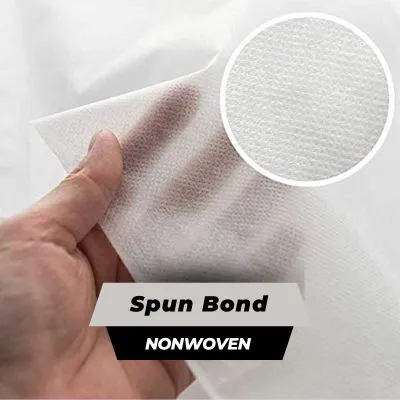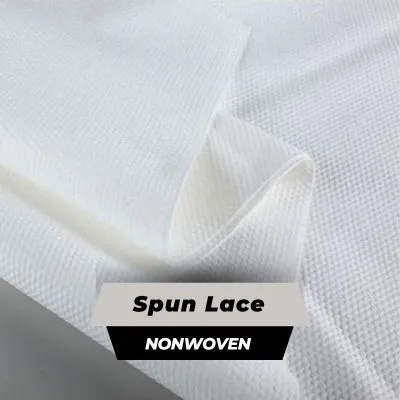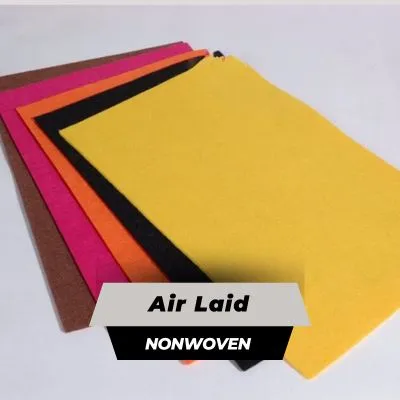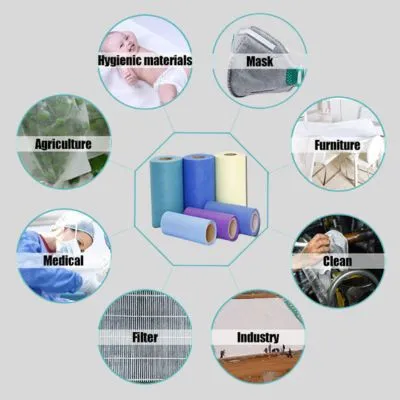If you are a beginner in the textile industry, you may have heard the term “Nonwoven fabric,” or what is Nonwoven Fabric? Nonwoven is one of the most popular and unique quality fabrics in the textile industry. It is a versatile fabric that is made from fibers that are bonded together without weaving.
The manufacturing process of nonwovens involves various methods, including spun bond, spun lace, malt blow, and so on. It is used in multiple industries and applications due to its unique properties, such as high porosity, softness, durability, and low cost. This article is going to discuss everything about these nonwovens that you need to know.

What is Nonwoven Fabric?
Nonwoven fabric is formed without forming and interlacing or intermeshing of fiber. non-woven textiles created using mechanical, chemical, or thermal techniques.
These fabrics consist of one or more layers of fibers and are flexible and porous. They are composed of sheet or web structures that are fused by interlocking fibers or filaments. These flat fabrics are made by combining separate fibers or molten plastic or plastic film.
Nonwoven fabrics are made specifically for each use, whether for industrial or consumer use. These fabrics can be thin and light or sturdy and durable. High-performance goods can be delivered thanks to incorporating their unique qualities through the choice of raw materials, the employment of forming and bonding techniques, or the use of finalizing treatments.
What is Nonwoven Fabric Made of?
Nonwoven fabric is directly made from fiber without forming yarn. It is composed of fibers, that have been mechanically, chemically, or physically woven into a web. Instead of being woven or knitted, nonwoven fabrics are created from fibers that are glued together mechanically, chemically, or thermally.
Nonwovens are often made of viscose, polyethylene, polyester, and polypropylene, while cotton can be utilized to manufacture products with medical end-use.
Learn More: 12 Basic Defects in Nonwoven Fabric Production
Different Types of Nonwoven Fabric
Nonwoven Fabrics are available in different types, including spud-bond, spun-lace, melt-blow, Air-laid, and so on. Every kind of non-woven fabric has various features.
Let’s explore different types of nonwoven fabrics in detail:
| Types of Non-Woven Fabric | Fabric Features | Applications |
| 1. Spun-Bond Nonwoven | – High strength | – Disposable products (e.g., diapers, wipes) |
| – Breathable | – Medical and hygiene products | |
| – Resistant to tearing and abrasion | – Agriculture (crop covers, weed control) | |
| – Lightweight and cost-effective | – Geotextiles (erosion control, soil stabilization) | |
| – UV resistant | – Packaging materials | |
| 2. Spun-lace Nonwoven | – Furniture upholstery | |
| – Soft and drapable | – Medical wipes and surgical gowns | |
| – Absorbent | – Personal care products (facial masks) | |
| – Porous structure | – Home and industrial cleaning wipes | |
| – Excellent fluid distribution | – Apparel interlinings | |
| – No binder required | – Automotive interior components | |
| 3. Melt-blown Nonwoven | – Filtration media | |
| – Microfiber structure | – Face masks and respirators | |
| – High filtration efficiency | – Surgical gowns and drapes | |
| – Low basis weight | – Air and liquid filtration | |
| – Good barrier properties | – Absorbent hygiene products (diapers) | |
| – Lightweight | – Oil absorbents | |
| 4. Air-laid Nonwoven | – Insulation materials | |
| – Soft and bulky | – Wipes and towels | |
| – Good absorbency | – Hygiene products (sanitary napkins) | |
| – Customizable thickness | – Tabletop and kitchen products | |
| – No bonding agents | – Industrial wipes | |
| – Thermal insulation properties | – Filtration media | |
| 5. Wet-laid Nonwoven | – Packaging materials | |
| – Smooth and uniform surface | – Disposable towels and napkins | |
| – High tensile strength | – Medical dressings and bandages | |
| – Excellent liquid absorption | – Industrial wipes | |
| – Moldable and conformable | – Filtration media | |
| – Can include natural fibers | – Non-apparel applications (bookbinding) | |
| 6. Stitch-Bonded Nonwoven | – Battery separators | |
| – High strength and durability | – Upholstery and mattress components | |
| – Dimensional stability | – Industrial filtration | |
| – Customizable designs | – Carpet backing | |
| – Resistant to fraying | – Shoe components | |
| – Bonded through stitching | – Geotextiles (reinforcement) |
1. Spun-Bond Nonwoven fabric

Manufacturing spunbond nonwoven fabrics involves extruding and stretching polymer to produce continuous filaments. These filaments are then interlaced through a melting and spinning procedure, producing a web of fibers. The fibers are strengthened and made more durable through the use of chemical, thermal, or mechanical bonding methods.
2. Spun-lace Nonwoven Fabric

Spun-lace non-woven fabric is made by entangling web fibers using high-pressure water jets. The process creates a uniform fabric with reinforced threads. Although not as durable and stable as other types of nonwoven fabrics, it is popular in making face masks, disposable surgical gowns, wet wipes, filters, etc.
3. Melt-blown Nonwoven Fabric

The melt-blown non-woven fabric also uses polymers to manufacture this fabric. However, it is passed through a straight-line die to create long, thin fibers instead. The threads are cooled using hot air, and the resulting fiber webs are then gathered on an accumulation screen. Here, the fibers come together to create the nonwoven fabric.
4. Air-laid Nonwoven Fabric

The procedure used for producing air-laid nonwovens involves opening the fluff pulp as well as suspending the fibers in the air in a formation process. Following the deposition of the threads on the forming screen, an adhesive is used to connect the batting, as well as the fibers are then dried.
5. Wet-laid Nonwoven Fabric

The production of a wet non-woven fabric involves many phases. The raw material, which consists of fibers, is first submerged in water to separate into a single fiber. The addition of various fibrous raw materials creates a slurry of fibrous suspension next. The mesh is then put in the wet condition it was treated in to make the fabric after the slurry was treated in a mesh-forming device.
6. Stitch-Bonded Nonwoven Fabric

Stitch-Bonded Nonwoven Fabric is another popular dry non-woven fabric. This fabric uses a wrap-knitted loop structure, which gives the yarn layer, fibers web, and the additional layers utilized in its production strength and structure. The fabric’s structure is strengthened by the mixing of multiple layers.
Properties of Nonwoven Fabric
| Fabric Name | Nonwoven Fabric |
| Manufacturing Materials | Viscose, polyethylene, polyester, polypropylene, cotton, and so on. |
| Fabric Durability | Excellent |
| Fabric strength | High |
| Absorbency Capacity | Good |
| Liquid Repellency | Variable |
| Tensile strength | High |
| Fabric drapability | Variable |
| Fabric launderability | Variable |
| Fabric Softness | Excellent |
| Applications | Medical Products, Industrial applications, home furnishing, Hygiene products, etc. |
Characteristics of Nonwoven Fabric
Nonwoven fabrics have gained popularity due to their unique characteristics, such as high porosity, low cost, and versatility. These fabrics are used in various industries, including healthcare, construction, and automotive.
Let’s take a look at the Characteristics of Nonwoven Fabric:
a. Eco-friendly Fabric
Nonwoven fabrics are one kind of eco-friendly Fabric. Non-woven textiles are extensively used in various industries due to their eco-friendliness. Due to polypropylene’s brittle chemical structure, its molecular chain is easily broken, enabling it to be dissolved and released back into the environment in an inert condition.
b. Durable and Lightweight
Nonwoven fabric can be reasonably sturdy and long-lasting. Applications that call for exceptional durability and resilience, such as geotextiles and industrial fabrics, frequently employ it. Non-woven fabrics are often constructed of polypropylene, which is excellently lightweight and gives them a fluffy and pleasant feel.
c. Versatile Fabric
Nonwoven fabrics can be tailored to specific applications by selecting the appropriate fibers, bonding methods, and finishing treatments. This allows them to be optimized for particular properties such as softness, abrasion resistance, or chemical resistance. Nonwoven fabrics can be used in different applications, from medical products to industrial applications.
d. Excellent Softness
Non-woven fabrics are soft and resilient, rigid and stiff, or large and not very pliable. These fabrics are perfect for applications wherein comfort is crucial, such as medical apparel as well as hygiene products.
e. Water Permeable
Nonwoven fabrics absorb and retain water better than woven fabrics of a comparable fabric density because of the fabric’s three-dimensional shape as well as space ratio. The completed product has high water repellency, does not absorb water, and contains no moisture.
Applications of Nonwoven Fabric
Non-woven fabrics are increasingly being used. Nonwovens have a wide range of applications and can be categorized as industrial materials, substantial consumer items, as well as disposables. Let’s take a look at the applications of Non-woven fabric.
| Application of Non-Woven | |||
| Household | Geotextiles | Industrial/Military | Health Care |
| Tea & Coffee Bags | Soli Stabilizer | Military Clothing | Lens Tissue |
| Aprons | Drainage | Coated Fabrics | Diapers |
| Table Clothes | Pond Liners | Conveyor Belt | Bandage & Tapes |
| Iron Boards Pad | Sedimentation & Erosion | Clear Room Apparel | Surgical caps, Gowns, Masks |
| Table Softener Sheets | Road & Railway | Air Conditioning Filters | Shoe Cover |

- Medical and Hygiene: Medical gowns, wound dressings, diapers, surgical masks, industrial masks, procedure packs, under pads, heat packs, bandages, wipes, towels,.
- Packaging: To make eco-friendly, customizable products.
- Agriculture: Crop protection, soil stabilization, and coverings of the greenhouse.
- Automotive: Car interiors, Seat upholstery, sound insulation, and carpeting.
- Construction and Geotextile: Roofing membrane, Insulation, Pipe wrap, House wrap, Flooring substrates, Roofing, acoustic ceiling covers, Vapor barrier, Air infiltration barrier, wall coverings, and erosion control and drainage.
- Clothing: Interlinings, insulation, and protection clothing
- Home: Wipes and Dusters, bed and table linen, Draperies, mattress padding, furniture upholstery, towels, carpet backing, table cloths, blankets, food wraps.
- Automotive: Boot liners, oil and cabin air filters, heat shields, airbags, and tapes.
- Industrial: Cable insulation, battery separators, satellite dishes, abrasives Filters, packing materials, insulation, roadbed stabilization, geo-textiles, sheeting, roofing products, etc.
- Hygiene products: Diapers, sanitary napkins, dust cloths, cleansing wipes, facial wipes, disposable bed sheets, disposable gloves, etc.
Common FAQs
What is non-woven fabric suitable for?
Nonwoven fabric offers numerous benefits, including increased resiliency, improved absorbency, enhanced washability, and protection against bacteria. Furthermore, nonwoven fabrics can be customized to enhance specific features such as resistance to liquids, impact, and flames, as well as electrical and thermal insulation.
Is non-woven waterproof?
Nonwoven textiles can be created with water resistance; nevertheless, not all nonwoven fabrics are waterproof. For instance, the structure of spun bond and melt-blown nonwoven materials makes them naturally water-resistant. It is possible to apply a water-repellent coating on other nonwoven textiles to make them water-resistant, including needle punch and air-laid.
What are the advantages of nonwoven fabric?
Nonwoven is one of the most popular textile fabrics that comes with several advantages. This fabric comes with excellent breathability, has good absorbency and flexibility, and is also light in weight. Along with these benefits, it is also easily de-composable, non-toxic, as well as non-irritating, has vibrant colors, is recyclable, etc.
Wrap Up
In conclusion, nonwoven is a flexible fabric that offers a range of benefits in various industries. The manufacturing process of nonwoven fabrics involves different methods, and it is commonly used in the medical, hygiene, construction, automotive, agriculture, and geotextile industries. Its versatility and widespread use make it a versatile fabric for different applications.
